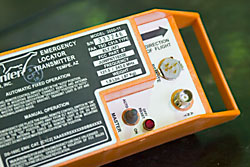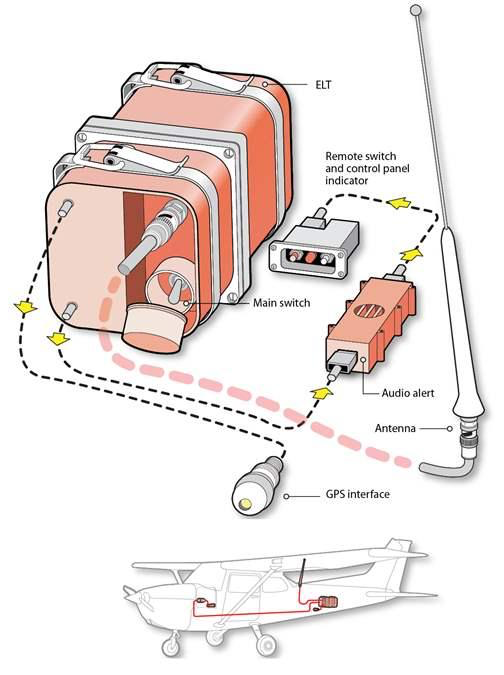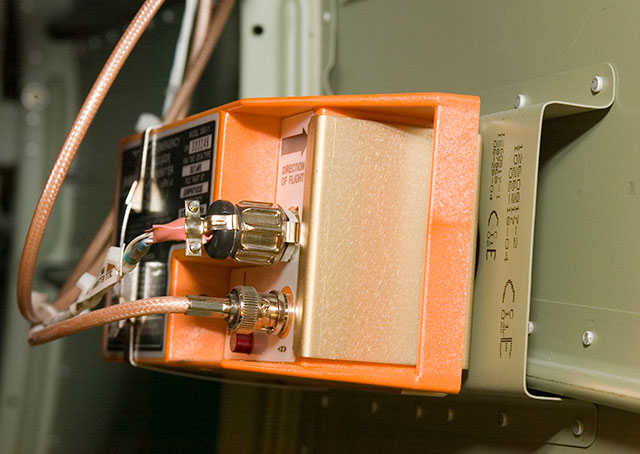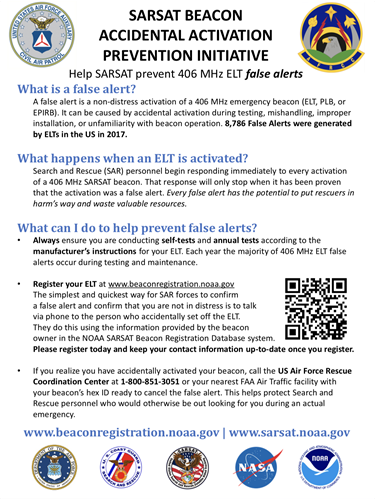EMERGENCY LOCATOR TRANSMITTER (ELT)

ELTs are emergency transmitters that are carried aboard most general aviation aircraft in the U.S. In the event of an aircraft accident, these devices are designed to transmit a distress signal on 121.5 and 243.0 MHz frequencies, and for newer ELTs, on 406 MHz. ELTs are required to be installed in almost all U.S.-registered civil aircraft, including general aviation aircraft, as a result of a congressional mandate. The mandate resulted from the 1972 loss of U.S. Representative Hale Boggs and Nick Begich in Alaska after their aircraft crashed and was never found.
When ELTs were mandated in 1973, most GA aircraft were equipped with an ELT that transmits on the 121.5 MHz frequency, the designated international distress frequency. The original ELTs were manufactured to the specifications of an FAA technical standard order (TSO-C91). Historically, these ELT’s have experienced an activation rate of less than 25 percent in actual crashes and a 97 percent false-alarm rate. In 1985, a new TSO-C91A ELT was developed, which substantially reduces or eliminates many problems with the earlier model. The TSO-C91A provides improved performance and reliability (with an activation rate of 73 percent in actual crashes) at a reasonable cost to users. Since then, an even more advanced model of ELT has been developed — the TSO-C126 ELT (406 MHz). This newest model activates 81-83 percent of the time and transmits a more accurate and near-instantaneous emergency signal by utilizing digital technology. This digital 406 MHz ELT also allows search and rescue personnel to have vital information specific to you and your aircraft.

ELTs were originally intended for use on the 121.5 MHz frequency to alert air traffic control and aircraft monitoring the frequency. In 1982, a satellite-based monitoring system was implemented, COSPAS-SARSAT, to provide a better way to detect these distress signals. In 2009, the international COSPAS-SARSAT satellite system discontinued satellite-based monitoring of the 121.5/243 MHz frequencies, in part because of a high number of false signals attributed with these frequencies. Satellite monitoring today utilizes the 406 MHz frequency only.
While there's no requirement in the United States to replace the first- and second-generation 121.5 MHz ELTs, since 2009, 121.5 and 243 MHz distress signals transmitted from ELTs operating on the lower frequency have only been able to be detected by ground-based receivers, such as local airport facilities and air traffic control facilities, or by overflying aircraft. Pilots should be aware that existing 121.5 MHz ELTs, although still legal from the FAA's perspective, will provide extremely limited assistance if an aircraft crashes, especially in a remote location. In 2019, the manufacture, importation, or sale of 121.5 MHz ELTs became prohibited in the United States per an FCC final rule, but the new rule does not prohibit aircraft operators from continuing to use 121.5-MHz ELTs now installed in aircraft, nor does it cut off the availability of batteries or other replacement parts.
Impact of False Alerts
The Air Force Rescue Coordination Center (AFRCC) is responsible for coordinating search and rescue activities in the 48 contiguous United States and will support search and rescue operations for American citizens in Mexico and Canada. This agency is alerted to an ELT activation and determines an appropriate response, sometimes resulting in Civil Air Patrol, United States Coast Guard, and other first responders initiating a search. The AFRCC can be reached at 1-800-851-3051.
In 2017, there were 8,898 406 MHz ELT activations in the AFRCC area of responsibility and about 98% of those alerts were false alarms. Just 122 of the alerts in 2017 were actual distress cases. For each false alert, AFRCC specialists put in considerable research and manhours to track down the ELT and owner. Each activation is treated as an emergency so each false alert is a distraction and negatively affects other search and rescue missions. About 90% of false alerts occur because of beacon mishandling during the testing and maintenance of these systems.
Whether utilizing a 121.5 MHz or 406 MHz ELT, owners should be familiar with the guidance in the Aeronautical Information Manual and the ELT Advisory Circular as far as preventing false alerts and conducting ELT testing in a responsible way. It is also a legal requirement for owners of a 406 MHz ELT to register their ELT to allow a faster response to an ELT activation. Additional information can be found in a July 2, 2018, Information for Operators notice from the FAA. Good practice for all pilots is to monitor 121.5 MHz when flying and prior to shutting down the aircraft as any activation of a 121.5 MHz ELT, such as due to a hard landing, will be immediately evident.
AOPA's Position on 406 MHz Mandate
AOPA supports the installation of these more advanced ELTs on a voluntary basis. General aviation is an industry already struggling under the weight of increased regulation and mandated equipage, and the decisions to replace an existing ELT should be left to the discretion of the aircraft owner. Therefore, AOPA does not support any attempt to mandate or otherwise require the replacement of existing 121.5/243 MHz ELTs with 406 MHz units. However, the association does support the education of pilots and aircraft owners as to the limits of 121.5/243 MHz ELTs and the benefits of 406 MHz units.
The benefits of advanced ELTs must be balanced against cost and the needs of the individual aircraft owner. An individual owner may opt to invest in accident prevention technology, such as Non Required Safety Enhancing Equipment (NORSEE) versus spending the same money on a 406 MHz ELT, which is only effective once an accident has occurred.
New Technologies offer Alternate Solutions
While ELT technology and certification has evolved slowly over the years, new technologies that utilize satellite communication networks have made products available that are designed for both tracking and distress alerting. Devices such as SPOT and Garmin Inreach provide tracking and distress alerting, but must be manually activated. Other systems, such as Spidertracks, provide automated alerting which is triggered if the tracking signal stops without proper shut-down notification. In the latter case, the loss of signal from an aircraft crash or mishap would trigger the distress call, rendering the issues of the system’s post-crash survivability and activation a moot point. While these devices are not certified by the FAA, or replace the legal requirement for an ELT, aircraft owners may want to investigate them as a safety enhancement in place of equipping with a 406 MHz ELT. The FAA has developed programs, such as the Enhanced Special Reporting Service (eSRS) which links certain devices to Flight Plans in Alaska. Adverse Condition Alerting Service (ACAS) offered by Leidos Flight Service provides a slightly different set of services, based on satellite tracking devices.
AOPA continues to monitor these technologies and services, which someday may lead to additional options for aircraft owners to meet FAA requirements, in the most cost effective manner possible.
International Requirements
The International Civil Aviation Organization (ICAO) standard is the 406 MHz ELT, which is mandatory in many countries for general and commercial aviation. Pilots should check the ELT requirement for any country they will be flying to or over. At this time, Canada requires an ELT that can transmit a signal on 121.5 MHz, and they highly recommend an ELT that can transmit over 121.5 MHz and 406 MHz. Mexico’s deadline for 406 Mhz ELTs on piston-powered private aircraft with a maximum takeoff weight of less than 12,566 lbs is June 30, 2018.
Frequently Asked Questions
CAN ADS-B REPLACE MY ELT?
IS A PERSONAL LOCATOR BEACON A REPLACEMENT FOR AN ELT?
CAN I USE VELCRO TO SECURE MY ELT?
The FAA recommends, but will not require, that ELTs be secured with metal fasteners. Velcro, or hook-and-loop fasteners, have performance issues that can impact an ELT’s operation.
Investigations into several aircraft accidents found that ELTs mounted with hook-and-loop fasteners did not transmit an emergency signal because they were dislodged from their mounting trays on impact, severing the antenna connection. These fasteners may not retain the ELT if insufficient tension is applied to close them, if they stretch or loosen over time, if debris contaminates the hooks and loops, or if the fasteners degrade because of environmental factors.
The FAA decided against mandates that it deemed would place an undue burden on aircraft owners and decided not to issue an airworthiness directive or policy prohibiting installation approval of units that use hook-and-loop fasteners. It also decided against withdrawing the TSO authorizations of ELTs utilizing hook-and-loop fasteners for mounting. Neither a revised policy nor withdrawal of TSO authorizations is needed, the FAA said in a Federal Register Notice, because manufacturers with ELT designs incorporating fasteners “which failed to perform their intended function in accidents either have revised or are in the process of revising their designs, minimizing the need for policy in this area.” The agency's choice to instead encourage voluntary action, the FAA noted, “avoids placing an undue burden on aircraft owners while acknowledging the voluntary efforts of ELT manufacturers to improve designs.”

CAN I TEST MY ELT TO MAKE SURE IT WORKS?
Pilots and installers should carefully follow manufacturer’s instructions and perform any tests to verify that the ELT will function as intended taking care to avoid triggering a false alert. Per the FAA's ELT Advisory Circular, care should be taken to prevent accidentally triggering a search and rescue response. Accidental activation of an ELT will generate an emergency signal that cannot be distinguished from that of an actual emergency and could lead to expensive and frustrating searches. Moreover, the unwarranted ELT signal could tie up the emergency frequencies such that a genuine emergency signal would not be picked up.
The Aeronautical Information Manual includes guidance on proper testing procedures. Regardless of where the ELT is, or the duration of activation, a 406 MHz ELT broadcast will be detected and a response initiated unless proper coordination is conducted in advance. Any testing of a 406 MHz ELT should be done in accordance with manufacturer instructions, and some include a “self-test” function. As required by law, pilots with a 406 MHz ELT must also register their ELT, which will allow an expeditious identification of a false alert. For 121.5 MHz ELTs, testing is approved during the first 5 minutes after any hour for a maximum of three audible sweeps.
HOW DO I DISPOSE OF AN OLD ELT?
Incorrectly disposed of ELTs have caused numerous false alerts and greatly increase the workload for first responders. In California, one Civil Air Patrol squadron searched through trash for six hours at a local recycling facility to locate an ELT and disconnect its battery. Pilots and mechanics should take care to dispose of an old ELT in a manner that assures it will not cause a false alert. The ELT manufacturer will normally include specific disposal guidance but removing the antenna and battery is the industry standard.
WHEN MUST I REPLACE MY ELT’S BATTERY?
- When the transmitter has been in use for more than 1 cumulative hour (accidental activation of an unknown duration may also require the battery be replaced); or
- When 50 percent of their useful life (or for rechargeable batteries, 50 percent of their useful life or charge) has expired, as established by the transmitter manufacturer under its approval.
WHAT MAINTENANCE IS REQUIRED FOR AN ELT?
A 1994 regulation change, 14 CFR Part 91.207(d), requires a separate sign-off or annual inspection for the ELT. The mechanic actually makes a separate log entry about the ELT. This usually will occur at the same time of the aircraft's annual inspection, but it doesn't have to. The unwary pilot in command could miss the timing on this inspection and find himself in the same trouble as if he had flown with an airworthiness directive compliance time missed. As we know, the mechanic's signature at an annual is a statement of condition at that time and does not guarantee that everything will remain airworthy until the next annual.
An unwary pilot can also miss the ELT battery replacement date. This is the "half-life" or FAR-prescribed replacement date, but very often this does not correspond with the timing of the annual inspection. It is the pilot in command's responsibility to know the replacement date; some owners will replace the battery early to coordinate it with the annual inspection. As mentioned, the pilot/operator can replace an ELT battery under preventive maintenance, 14 CFR Part 43. This only holds true, however, for a battery with plug-in or snap-on connector replacement, one where no soldering is required. The pilot performing this work has the same responsibility as a mechanic to make a log entry for the work and the new battery date, as well as perform a simple function test after the new battery is installed. This test should constitute simply turning on the unit with the toggle switch and listening on a com radio on 121.5 MHz for three sweeps of tone. For obvious reasons, regulations prescribe this to be done only at five minutes after the hour and only after coordination with any FAA control tower within line-of-site distance. Note: This simple pilot function test does not meet the G-switch/signal-strength test that a mechanic must perform and endorse annually.
DOES ANYONE STILL MONITOR 121.5 MHZ ELTS?
Even though satellites no longer monitor 121.5 MHz signals, the search and rescue community will still respond when notified through other means. ELTs were originally intended to use 121.5 MHz to inform air traffic control and pilots monitoring the frequency of an emergency. These ELTs continue to serve in that role, relying on fellow pilots and ground-based radio facilities to monitor the signals. As a best practice, pilots should monitor 121.5 MHz when flying and report to air traffic control any ELT alert heard. Existing 121.5 MHz ELTs continue to meet the FAA’s regulatory requirements, but 406 MHz ELTs also meet the regulatory requirement, are monitored by satellites, and enable a more accurate search and rescue response.
